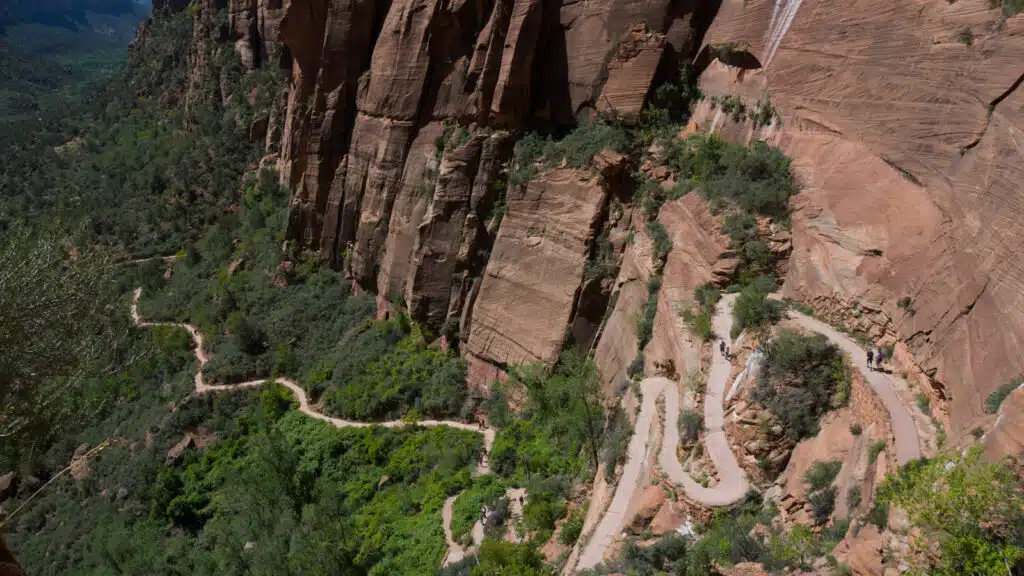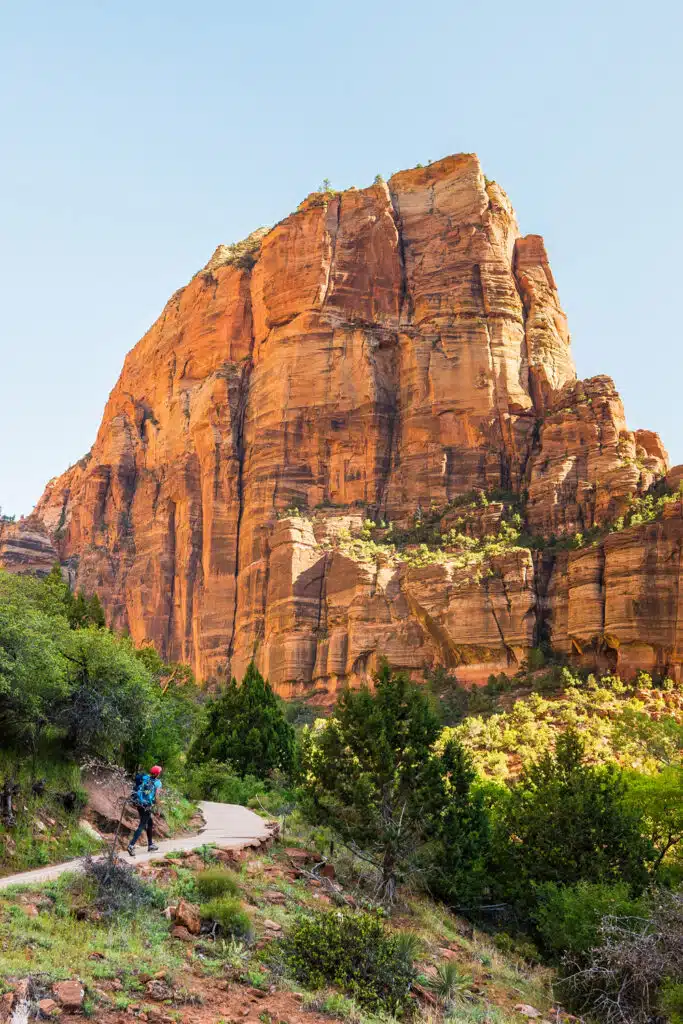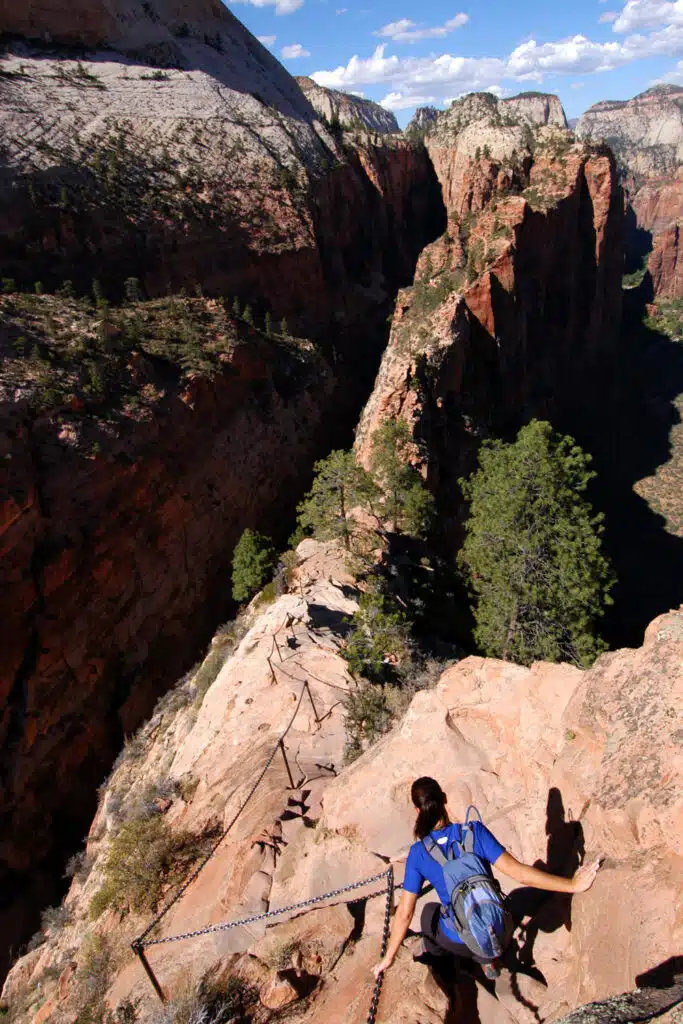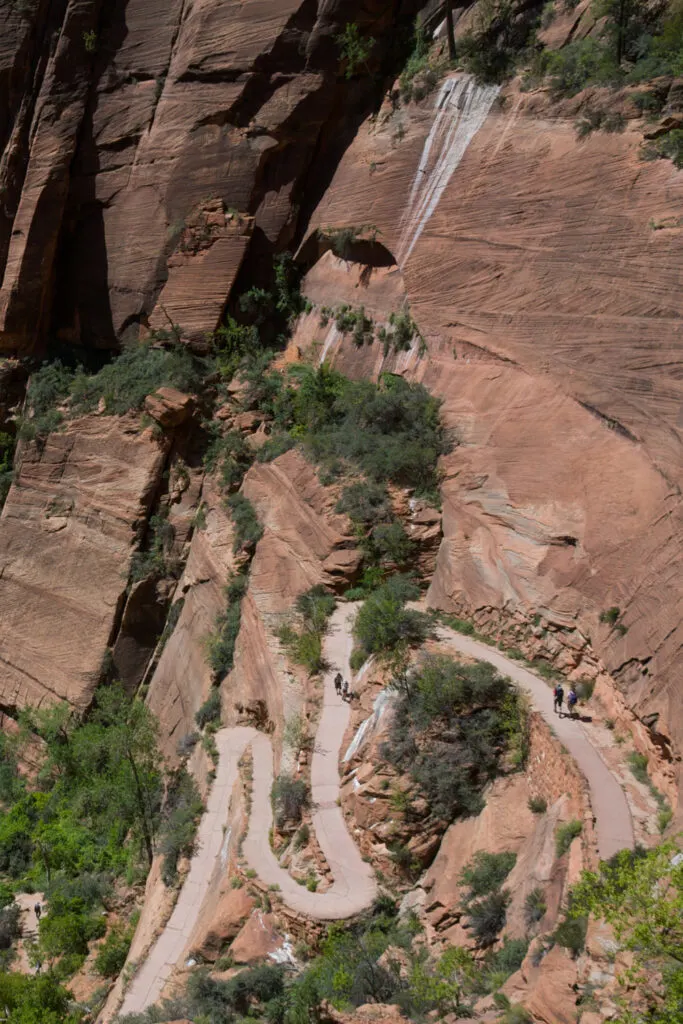Switchback hiking isn’t for the faint-hearted. Whenever I see the name switchback trail I know I’m in for a long hard slog up a steep hill. But getting to the top of the trail is always worth it. A rewarding view awaits, and as my limbs and lungs recover from the hard effort, there’s that deep sense of achievement.
So, what is a switchback on a hiking trail? A switchback in hiking terms is a trail that zig-zags up a hill or mountain. Instead of climbing steeply up a straight trail, the trail cuts back and forth across the slope at a lesser incline. Switchback trails are longer than the direct route but not as steep making the climb a little easier.

What’s A Switchback Hiking Trail?
The switchbacks on some trails are so long they become notorious. Hikers will call these types of trails a “switchback trail” or “switchback hike”. Expect a long day climbing a continuously steep path. Make sure you pack your hiking poles!
Following a zig-zag pattern may be easier than going straight up a mountain but the trail will still be strenuous to follow.
What is the purpose of switchbacks?
There are a few reasons why switchbacks are built on hiking trails. The most common reason is to make the incline more manageable and safer.
Originally built for pack animals
Many switchback trails around the world were originally built for pack animals carrying heavy loads. Trail planners created a less steep route that was easier for a pack animal to follow, especially on uneven terrain.
These days hikers can follow the same historic trails at a steady pace. Switchbacks are the best way to climb to a high pass and most hikers prefer climbing at their consistent gradient instead of directly up the mountainside.
Safer for climbing icy trails
Switchbacks have their uses in mountainous regions where trails are covered in snow and ice. Even with crampons and hiking shoes or boots, it’s a lot safer to climb icy terrain to the top of a mountain pass by crossing the slope’s face back and forth along a switchback path. Climbing directly up the steepest grade climbs may be quicker but it’s often a lot more dangerous.
Controls soil erosion
Another reason for a switchback trail is erosion control. When water runs down a mountainside path, it can create gullies – washing out the path and making the trail impassable. Switchbacking across a slope acts as an erosion control device – the water is dispersed over a larger area, preventing further erosion.
Some switchbacks occurred naturally
Some of the first switchback hiking routes occurred naturally. Zig-zagging across a slope is intuitive when you’re faced with difficult terrain. Even animals will create a zigzag trail. Next time you’re out for a day hike, watch how sheep climb – they rarely climb a slope directly.
Makes trails more accessible
These days trail builders also use switchbacks to make a route more accessible. It’s a way to build a well-maintained trail with gentler gradients that can be used by beginner hikers and hikers of all ages.

Which Is Better – Switchback Trails Or Direct Straight Line Route?
It depends on your fitness level and how much time you have. Hiking straight up is always going to be a lot tougher. You may end up clambering over loose rocks, but unless you burn out and have to stop for a rest, the straight path up will always be quicker. Taking the direct route can save a lot of time on steep terrain but it’s rarely a good idea.
Even fit trail runners often prefer following switchbacks. If you’re a strong runner it’s possible to keep running up a zigzagging trail. With a direct route, even the best runners are reduced to a walking pace.
You could be adding to excessive erosion by displacing loose rocks and soil. Always be very careful where you place your hiking boot or hiking poles and avoid kicking stones down on other hikers below.
Switchbacks let you climb steep slopes in a more sustainable way. By following the switchbacks other hikers will appreciate your efforts to protect the trail.
Hiking Tips For A Switchback Trail
You will find lots of tips about hiking in my hiking for beginners guide but here are a few extra tips for long day hikes on a switchback trail:
- Start early to avoid being benighted or caught out by afternoon thunderstorms on a hot day.
- Climb at your own pace and rest when you need to. It’s not a race.
- Use your hiking poles – it will help to take the strain off your legs and back.
- Dig deep – accept that the hike will take time and stay positive.
- Take plenty of water and snacks to keep your energy levels up.
- Wear sunscreen and a hat even if it’s cloudy – the sun’s UV rays can be really strong in the mountains.
- Take these essential items: navigational aids, headlamp, sun protection, first aid kit, waterproof jacket, waterproof pants, spare clothing, spare food, and an emergency bivy bag.
- Wear appropriate footwear – hiking boots or shoes with good grip.
- If the trail is busy, be courteous to other hikers and pass people on the outside of switchbacks.
- Don’t squeeze past other walkers on the trail. Wait at a wider point in the trail where it’s safe to pass.
Switchback Trail For Mountain Bikes
A switchback for mountain biking is a little different. It’s a tight 180-turn on a section of the trail without a berm. These switchbacks can be used for both uphill and downhill sections.
On natural trails, switchbacks enable mountain bikers to ride the ascent without getting off to push or carry their bikes.

Famous Switchback Trails
It’s a tough call choosing a shortlist of great trails but these are some of the best in America:
Heather Park Trail, Washington
A seemingly endless climb up a switchback trail, with lots of false summits, leads to Heather Park in the Olympic National park. It’s a challenging trail but the scenic views from the top are absolutely breathtaking.
Angels Landing, Zion National Park
Often billed as the scariest hike in America, this trail in Utah is certainly for people with a head for heights! Classic switchbacks lead to a very exposed summit. Cling on tightly to the chain handrails as you look straight down into Zion Canyon. It’s a beautiful view if you dare to look. A top hike if you’re looking for outdoor adventure!
Barr Trail To Pikes Peak, Colorado
This is a hiking experience you won’t forget in a hurry! The trail climbs a massive 7,400 feet to the summit of Pikes Peak.
Switchback Railroad Trail, Pennsylvania
The trail is built on the former gravity railroad tracks. If you start at Summit Hill it’s downhill all the way. A roller coaster of a ride. In reverse, from the downtown Jim Thorpe switchback trailhead, it’s a stiff challenging climb! It’s a route that’s popular with mountain bikers.
So there you have it. A switchback on a hiking trail is a hairpin turn. They are built to help hikers (and mountain bikers) climb steep slopes in a safer, more sustainable way. Be prepared for a long day hike if you’re tackling one of America’s famous switchback trails! And most importantly, enjoy the views from the top!
Did I miss your favorite trail? Let me know in the comments below…
If you’ve enjoyed this post you may like these other hiking posts:

